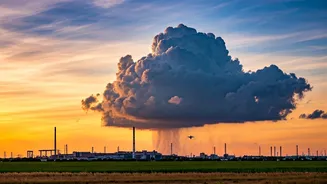Cyclone Genesis Unveiled
Cyclones, often referred to as hurricanes or typhoons depending on their location, develop due to a confluence of several atmospheric conditions. The genesis
of a cyclone primarily hinges on warm ocean waters, typically with temperatures above 26.5 degrees Celsius (80 degrees Fahrenheit). This heat provides the energy needed to fuel the storm. As warm, moist air rises from the ocean's surface, it creates an area of low pressure. This air then cools and condenses, forming clouds and releasing latent heat – the energy stored in water vapor. This process further warms the surrounding air, causing it to rise and create more low pressure, thus intensifying the cycle. The Earth's rotation, a phenomenon known as the Coriolis effect, plays a crucial role in the development of the swirling motion characteristic of cyclones. The Coriolis effect deflects moving air and water, causing them to rotate. In the Northern Hemisphere, this deflection leads to a counterclockwise rotation, while in the Southern Hemisphere, it results in a clockwise rotation. Additionally, a pre-existing atmospheric disturbance, like a tropical wave, is typically required to initiate the cyclone formation. This disturbance provides the initial lift to get the process started. Favorable wind conditions, such as minimal vertical wind shear (the change in wind speed and direction with height), also contribute to the cyclone's growth. High wind shear can disrupt the storm's structure, preventing it from intensifying. When all these elements align, a cyclone can rapidly evolve, growing in size and power.
Classifying Cyclone Strength
The classification of cyclones is primarily based on their sustained wind speeds. This categorization helps to assess the potential damage and inform preparedness efforts. Several scales are utilized, with the Saffir-Simpson Hurricane Wind Scale being the most well-known. This scale categorizes hurricanes (cyclones in the Atlantic and Northeast Pacific) into five categories based on their sustained wind speeds. Category 1 hurricanes have winds of 74-95 mph (119-153 km/h), causing minimal damage like damage to some roofs and trees. Category 2 storms, with winds between 96-110 mph (154-177 km/h), can inflict more substantial damage, including damage to homes. Category 3 hurricanes, possessing winds of 111-129 mph (178-208 km/h), are considered major hurricanes and can cause significant structural damage. Category 4 hurricanes, with winds of 130-156 mph (209-251 km/h), inflict catastrophic damage, while Category 5 hurricanes, the most severe with winds exceeding 157 mph (252 km/h), cause widespread and extreme destruction. In other regions, like the Northwest Pacific, cyclones are known as typhoons and are classified using similar wind speed thresholds, though specific categories may vary. The intensity of a cyclone is continuously monitored through various methods, including satellite imagery, aircraft reconnaissance, and surface observations. This ongoing monitoring allows for adjustments to warnings and advisories as the storm evolves, ensuring communities have the most accurate and up-to-date information.
Forecasting Cyclone Behavior
Forecasting cyclones is a complex undertaking, relying on a variety of data sources and sophisticated computer models. Accurate predictions are vital for minimizing the loss of life and property. Meteorologists employ several key elements in cyclone forecasting. These include understanding the current atmospheric conditions, using numerical weather prediction models, analyzing satellite and radar data, and incorporating observations from aircraft reconnaissance and surface stations. Numerical weather prediction (NWP) models are at the heart of cyclone forecasting. These models use complex mathematical equations to simulate the behavior of the atmosphere. They ingest vast amounts of data, including measurements of temperature, pressure, wind speed, and humidity, to create forecasts of a cyclone's track, intensity, and potential impacts. Satellite imagery provides a crucial overview of a cyclone's structure and movement. Satellites can measure cloud patterns, sea surface temperatures, and wind speeds, providing vital data for tracking and analysis. Radar systems, particularly those located near coastlines, also contribute critical information by providing detailed views of a storm’s precipitation and structure. Aircraft reconnaissance, where specially equipped aircraft fly directly into cyclones, provides invaluable data about the storm's intensity, wind speeds, and internal structure. Surface observations, including data from weather stations, buoys, and ships, provide additional localized information. Forecasting a cyclone's track involves estimating its future position, typically represented by a cone of uncertainty, which indicates the potential range of possible paths. Intensity forecasting is far more difficult, as cyclones can change in intensity unexpectedly. While forecasting has significantly improved over the years due to advancements in technology and data, inherent uncertainties still exist, emphasizing the importance of continuous monitoring and adaptation to the latest information.











